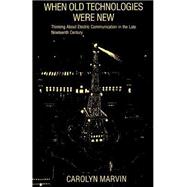When Old Technologies Were New Thinking About Electric Communication in the Late Nineteenth Century

When Old Technologies Were New Thinking About Electric Communication in the Late Nineteenth Century
- ISBN 13:
9780195063417
- ISBN 10:
0195063414
- Edition: Reprint
- Format: Paperback
- Copyright: 05/24/1990
- Publisher: Oxford University Press
.svg) Rent
From $29.77
Rent
From $29.77
List Price $50.12 Save
| TERM | PRICE | DUE |
|---|---|---|



List Price $50.12 Save $11.95
Usually Ships in 24-48 Hours
We Buy This Book Back!
Free Shipping On Every Order
List Price $50.12 Save $0.50
Print on Demand: 2-4 Weeks. This item cannot be cancelled or returned.
We Buy This Book Back!
Free Shipping On Every Order
Note: Supplemental materials are not guaranteed with Rental or Used book purchases.
Extend or Purchase Your Rental at Any Time
Need to keep your rental past your due date? At any time before your due date you can extend or purchase your rental through your account.







